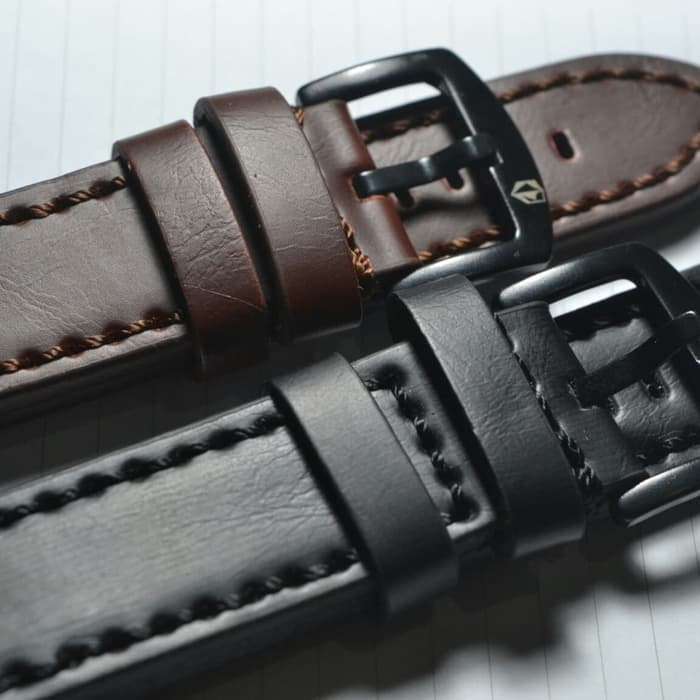Have you ever bought a leather strap for your favorite vintage watch only to find it cracking, peeling, or even staining your wrist after just a few wears? It happens more often than you think, especially if you're new to the world of vintage watches. So, what exactly separates the genuine from the subpar? Let's dive in!
What's the Difference Between Genuine Leather and Cheap Alternatives?
First things first: "genuine leather" is a tricky term. Many assume "genuine leather" always means quality, but in reality, it's often the lowest quality leather you can buy. Yes, it's real leather, but it's typically made from lower-grade material that can crack or degrade quickly.A truly quality strap, like handmade genuine leather straps, usually involves higher-grade leather such as full-grain or top-grain. Full-grain leather retains all natural characteristics of the hide, providing durability and longevity. Look for the subtle, natural markings—a clear sign of authenticity.
Types and Grades of Leather Used for Watch Straps
- Full-Grain Leather (Highest Grade): Natural surface, ages gracefully, develops a beautiful patina. Ideal for premium watch straps.
- Top-Grain Leather (High Grade): Slightly sanded for uniform appearance, good quality. Suitable for mid-to-high range straps.
- Genuine Leather (Moderate Grade): Lower quality, often layered or bonded; prone to wear but affordable.
- Bonded Leather (Low Grade): Made from leather scraps bonded with adhesive, lacks durability. Best for budget or temporary use.
Varieties of Leather Commonly Used for Watch Straps
- Cowhide: Common, strong, affordable, and versatile. Offers classic, casual elegance ideal for everyday wear and classic styles.
- Crazy Horse: Wax-treated cowhide with a rugged appearance; develops a unique patina. Excellent for vintage or rugged watch styles.
- Snake: Exotic texture, delicate and elegant. Perfect for dress watches or formal occasions due to its unique, sophisticated look.
- Crocodile: Luxurious with distinctive patterns and high durability. Ideal for luxury watches and formal wear, giving a prestigious appearance.
- Lizard: Refined and intricate patterns, thin yet durable. Suits elegant, formal watches with sleek and refined aesthetics.
How Can Stitching Reveal the Quality of a Leather Strap?
Stitching is more important than it appears. High-quality straps typically showcase meticulous, even stitching without loose threads or irregularities. Stitching should not only be consistent but tight and well-finished. Poor stitching can cause your strap to unravel, quickly turning your vintage watch into an unwearable artifact.If you own a genuine leather strap for Seiko vintage watches, the stitching is usually hand-stitched, enhancing durability. Compare this with machine-stitched straps that are mass-produced—often you’ll spot uneven stitches that fray over time.
Why Does Hardware Matter When Choosing a Leather Watch Strap?
Hardware is the unsung hero of a watch strap. Clasps and buckles need to match the quality of the leather. Cheaper straps use low-quality metal or plastic buckles that can break or corrode, damaging the overall aesthetic and longevity of your watch.Quality leather straps feature stainless steel, brass, or even precious metals that resist corrosion and add elegance. Remember, if you're investing in a classic leather strap for vintage watches, make sure the hardware complements its timeless charm.
Does the Finish and Feel Really Indicate Quality?
Absolutely! A high-quality strap feels supple yet sturdy to the touch. Poor quality leather straps tend to be stiff, overly glossy, or feel excessively "plasticky." Good leather ages gracefully—softening slightly, developing a rich patina, and becoming more comfortable with time.Check for natural texture. A truly good strap feels pleasant to touch and doesn’t exhibit artificial gloss. When choosing a strap for cheap old money watches, the finish should reflect subtle elegance, not overt shine.
Why Should You Consider the Edges of a Leather Strap?
Edge finishing often distinguishes a superior leather strap. A well-made strap features polished, painted, or burnished edges, ensuring durability and preventing fraying. Lower-quality straps have raw edges, prone to rapid wear, flaking, and discomfort.Quality manufacturers painstakingly seal or burnish edges, significantly increasing the lifespan of the strap and boosting overall aesthetics. This attention to detail often goes unnoticed until your strap begins falling apart prematurely.
How Does Leather Thickness Impact the Quality?
Thickness matters depending on your style and comfort preference. A thinner leather strap isn't inherently poor quality—it's often desirable for vintage or small wrist leather strap options. However, excessively thin leather may indicate shortcuts in manufacturing or cost-saving measures.Ideal thickness typically ranges between 2mm and 4mm, providing durability without sacrificing comfort or flexibility. Look for consistent thickness throughout the strap as unevenness suggests lower manufacturing standards.
What Role Does Smell Play in Identifying Leather Quality?
Authentic, high-quality leather has a distinctive earthy smell, almost reminiscent of wood or subtle musk. Poor quality or faux leather either smells overly chemical-like or completely odorless, highlighting synthetic treatments or low-quality materials.Smelling leather might seem odd at first, but it's a quick way to validate authenticity. Genuine handcrafted straps exhibit a natural fragrance, hinting at superior material selection and limited chemical treatment.
Where Can You Reliably Purchase High-Quality Leather Straps?
Knowing quality indicators is only half the battle. Equally crucial is sourcing from trusted vendors. If you're wondering where to buy second hand watches or superior straps, reputable vintage-focused stores such as Garasi Opung are excellent places to start.Trusted sellers usually provide detailed product descriptions, material specifics, and transparent origins. This openness helps buyers confidently identify top-tier leather products without doubts about their authenticity or longevity.
Final Thoughts: Is Quality Really Worth the Cost?
Ultimately, choosing the right leather strap isn't merely about aesthetics or luxury—it's about ensuring comfort, durability, and a genuine appreciation for craftsmanship. Invest wisely in your leather straps, and your vintage watches will reward you with timeless elegance and lasting satisfaction.

